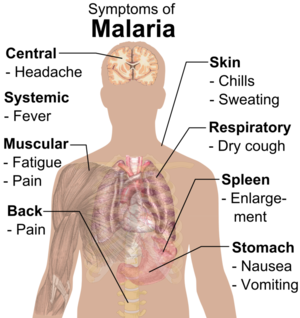The Skin Microbiome and Malaria: Difference between revisions
Petriceksa (talk | contribs) |
Petriceksa (talk | contribs) |
||
| Line 3: | Line 3: | ||
[[Image:Malaria Sypmtoms.png|thumb|300px|right|Symptoms of Malaria infection. Photo from Mikael Haggstrom, Wikiversity Journal of Medicine. [doi: 10.15347/wjm/2014.008].]] | [[Image:Malaria Sypmtoms.png|thumb|300px|right|Symptoms of Malaria infection. Photo from Mikael Haggstrom, Wikiversity Journal of Medicine. [doi: 10.15347/wjm/2014.008].]] | ||
<br>By Aldis Petriceks<br> | <br>By Aldis Petriceks<br> | ||
<br><b>Double brackets:</b> [[ | <br><b>Double brackets:</b> [[ | ||
<br><b>Closed double brackets:</b> ]] | <br><b>Closed double brackets:</b> ]] | ||
<br><b>Bold</b> | <br><b>Bold</b> | ||
<br><i>Italic</i> | <br><i>Italic</i> | ||
| Line 17: | Line 15: | ||
<br><b>Superscript:</b> Fe<sup>3+</sup> | <br><b>Superscript:</b> Fe<sup>3+</sup> | ||
<br>Malaria is a deadly disease caused by the protozoan <i>Plasmodium</i>, and spread through mosquito bites. <ref>[http://www.cdc.gov/malaria/ CDC, (2016). "Malaria"]</ref> <br> | <br>Malaria is a deadly disease caused by the protozoan <i>Plasmodium</i>, and spread through mosquito bites. <ref>[http://www.cdc.gov/malaria/ CDC, (2016). "Malaria"]</ref> The most common ailments are fever, chills, and flu-like symptoms which typically begin within a month of infection <ref>[http://www.ebmedicine.net/topics.php?paction=showTopic&topic_id=405 Caraballo 2014, "Malaria, Dengue, and West Nile Virus"]</ref>. Other symptoms include headache, vomiting, jaundice, shivering, and joint pain. The most notable sign of a malaria infection is paroxysm – which includes cycles of cold and shivering followed by fever and sweating. While immediate treatment can typically facilitate a full recovery, those without access to medical care can fall fatal to the disease within days. There are currently 3.4 billion people living in high-risk areas, which led to 500,000 deaths from malaria in 2013 alone (CDC). The majority of these deaths occur in underdeveloped tropical and sub-tropical countries, which in turn incur the bulk of the $12 billion USD yearly cost associated with fighting the disease. | ||
<br> | |||
<ref>[http://www.ncbi.nlm.nih.gov/pmc/articles/PMC3847443/ Bartlett et al.: Oncolytic viruses as therapeutic cancer vaccines. Molecular Cancer 2013 12:103.]</ref> | <ref>[http://www.ncbi.nlm.nih.gov/pmc/articles/PMC3847443/ Bartlett et al.: Oncolytic viruses as therapeutic cancer vaccines. Molecular Cancer 2013 12:103.]</ref> | ||
<br><br>A citation code consists of a hyperlinked reference within "ref" begin and end codes. | <br><br>A citation code consists of a hyperlinked reference within "ref" begin and end codes. | ||
Revision as of 14:01, 25 April 2016
Introduction
By Aldis Petriceks
Double brackets: [[
Closed double brackets: ]]
Bold
Italic
Subscript: H2O
Superscript: Fe3+
Malaria is a deadly disease caused by the protozoan Plasmodium, and spread through mosquito bites. [1] The most common ailments are fever, chills, and flu-like symptoms which typically begin within a month of infection [2]. Other symptoms include headache, vomiting, jaundice, shivering, and joint pain. The most notable sign of a malaria infection is paroxysm – which includes cycles of cold and shivering followed by fever and sweating. While immediate treatment can typically facilitate a full recovery, those without access to medical care can fall fatal to the disease within days. There are currently 3.4 billion people living in high-risk areas, which led to 500,000 deaths from malaria in 2013 alone (CDC). The majority of these deaths occur in underdeveloped tropical and sub-tropical countries, which in turn incur the bulk of the $12 billion USD yearly cost associated with fighting the disease.
[3]
A citation code consists of a hyperlinked reference within "ref" begin and end codes.
Section 1
Include some current research, with at least one figure showing data.
Every point of information REQUIRES CITATION using the citation tool shown above.
Section 2
Include some current research, with at least one figure showing data.
Mosquito-Attracting Skin Bacteria

Section 4
Conclusion
References
Authored for BIOL 238 Microbiology, taught by Joan Slonczewski, 2016, Kenyon College.

